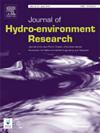Experimental study on surface wave interaction with submerged tensioned barriers using IoT image processing
Abstract
The present study investigated experimentally the dynamic interactions between surface waves and submerged vertical tensioned barriers with full and partial penetrations. The range of tension for the barrier was set within the flexible membrane regime in the experiments which measurements have not been reported in the literature so far. In addition, an extensive Internet of Things (IoT) system with five GoPro cameras was developed for the measurements to quantify both the surface wave transformation as well as dynamic response of the barrier. The cameras were synchronized through the IoT system to cover the entire wave flume, and the recorded videos were converted to spatial and temporal data using image processing techniques. The experimental results were found to agree with the analytical predictions based on the linear wave theory reasonably well. In particular, the measured reduction in the tensioning effect on the wave transmission and reflection with decreased barrier length was in close argument with the predictions. Similar good agreement was also observed for the dynamic response of the tensioned barrier during the wave interaction. However, additional energy loss was noted in the experiments possibly due to energy dissipation at the boundary ends of the experimental barrier and wave-induced flow separation with partial penetration which are not considered in the analytical analysis.

 求助内容:
求助内容: 应助结果提醒方式:
应助结果提醒方式:


